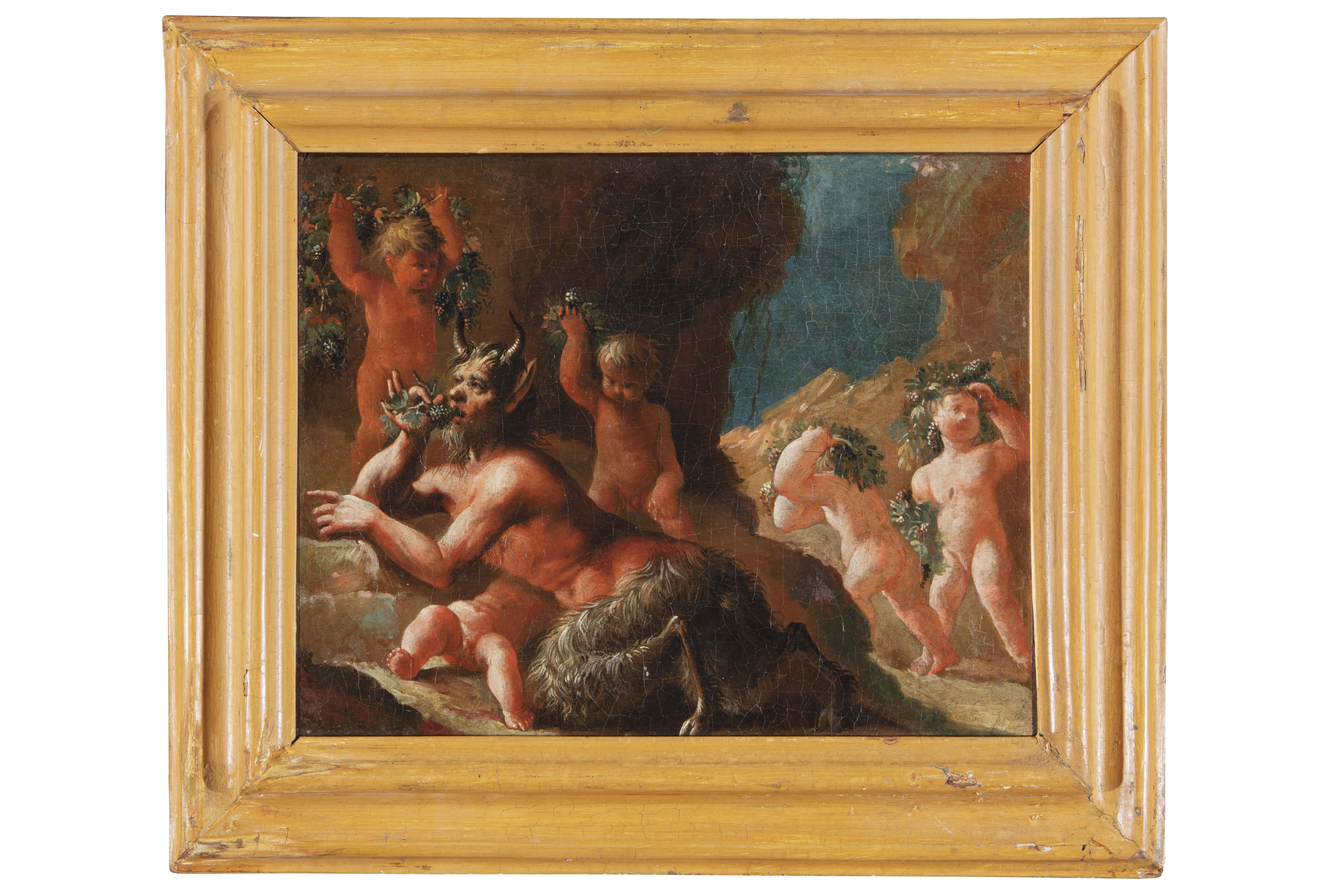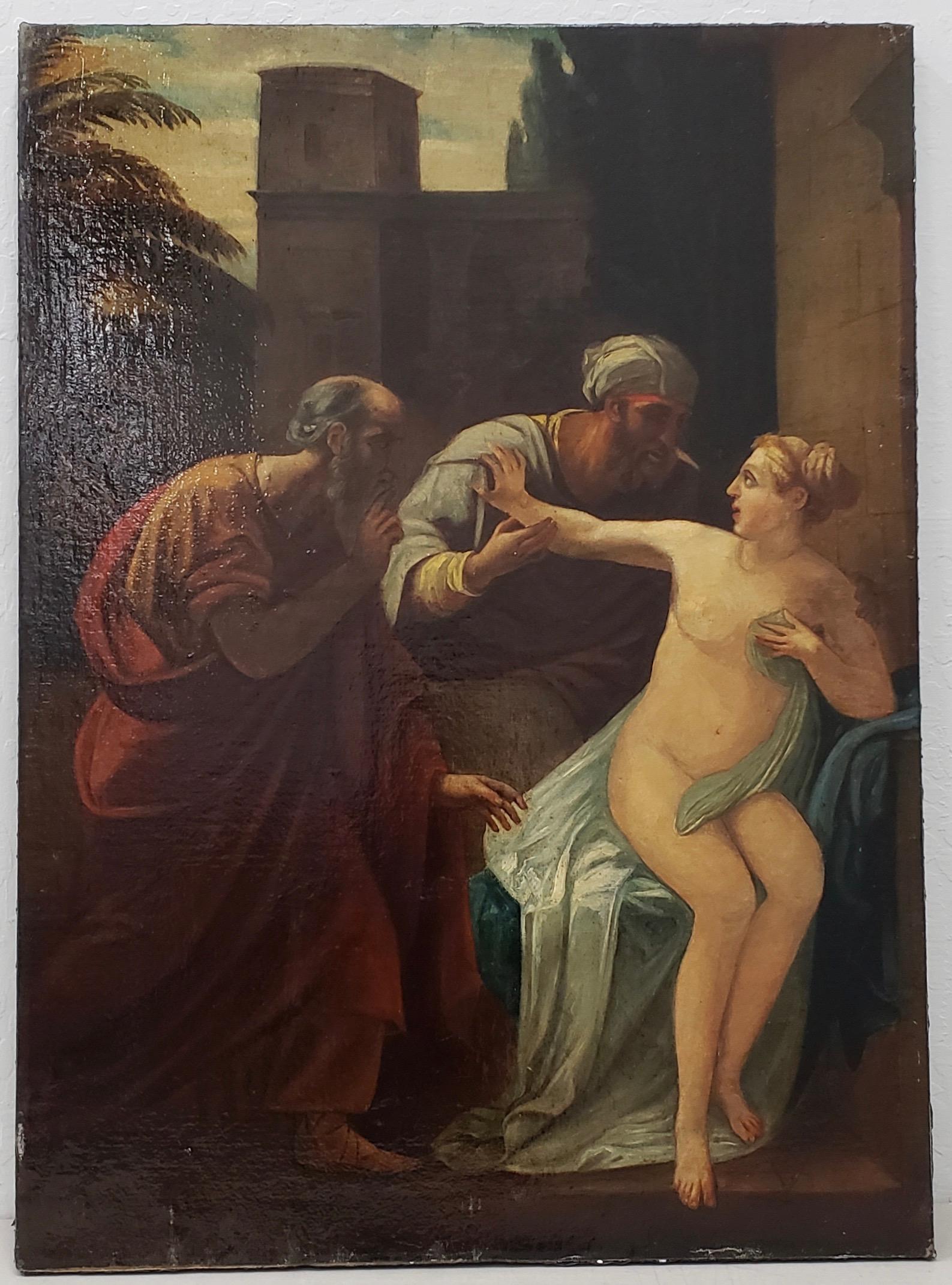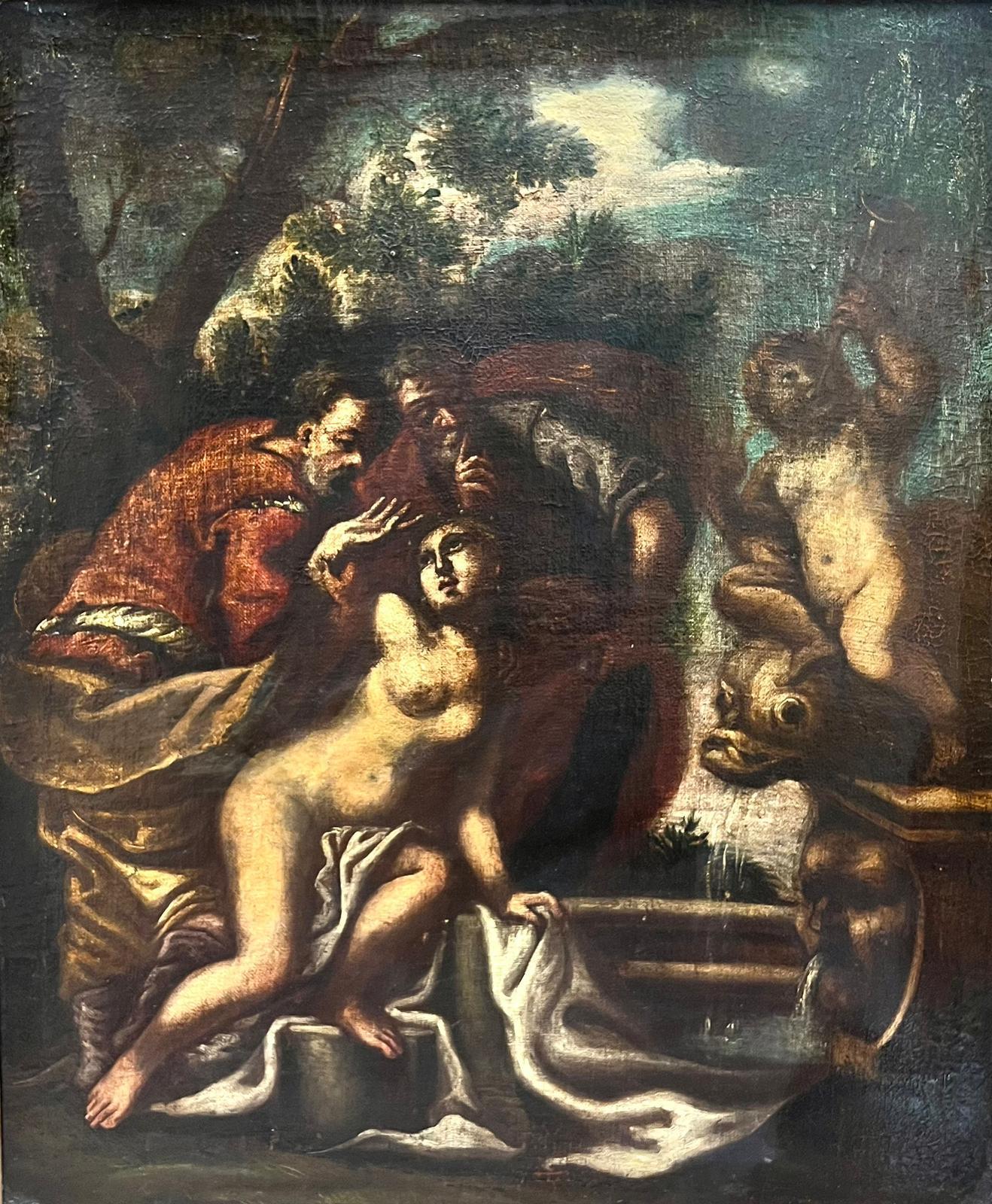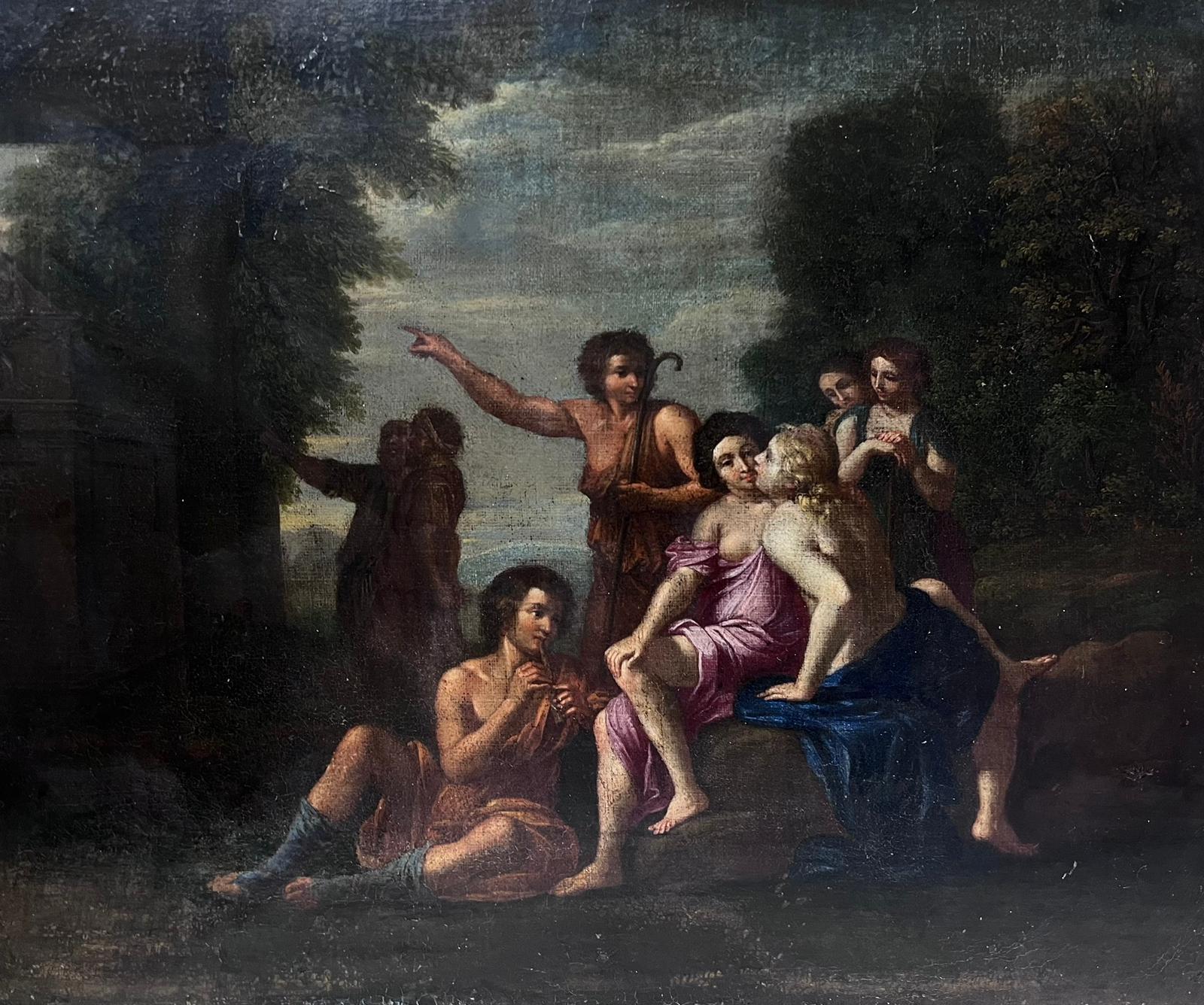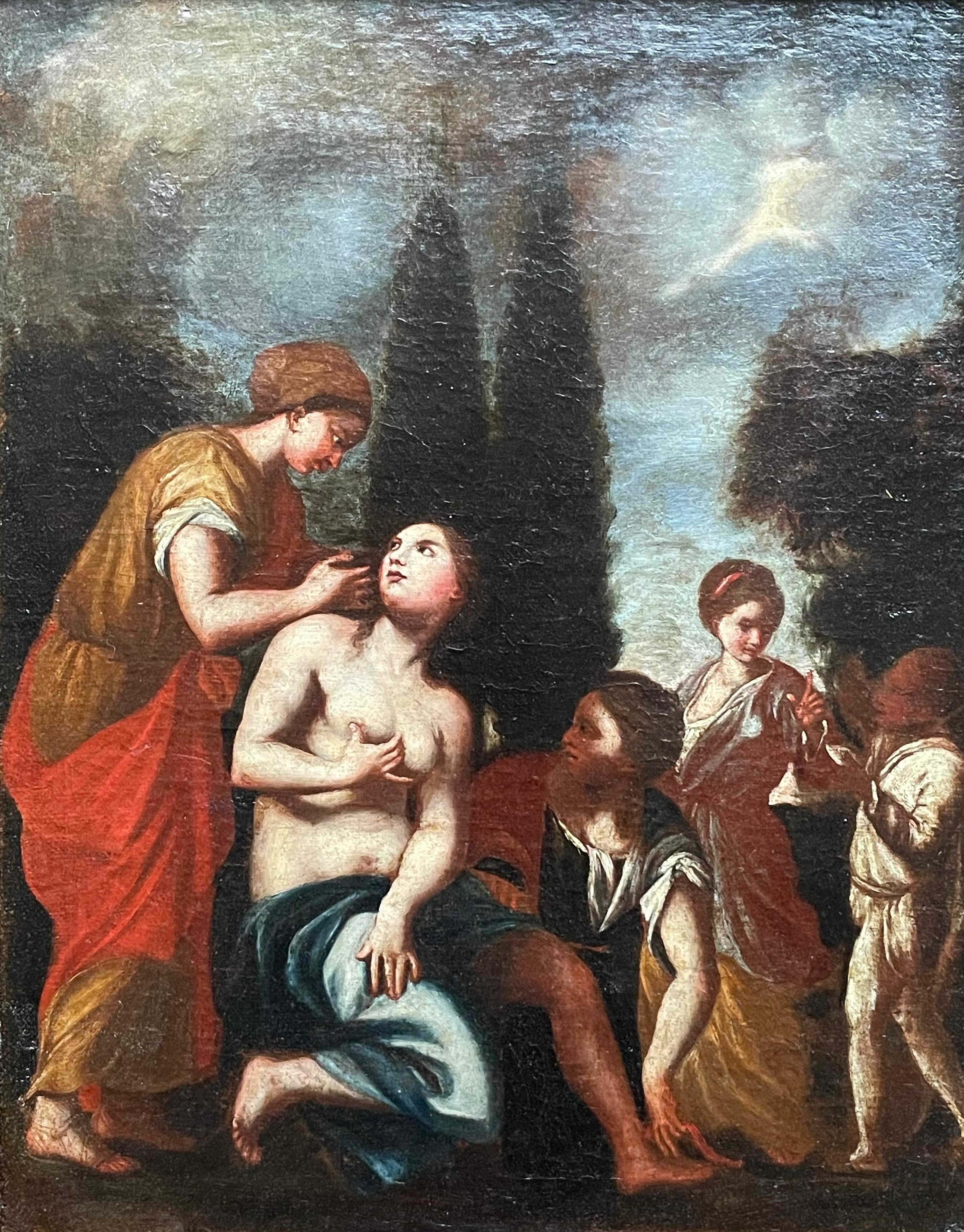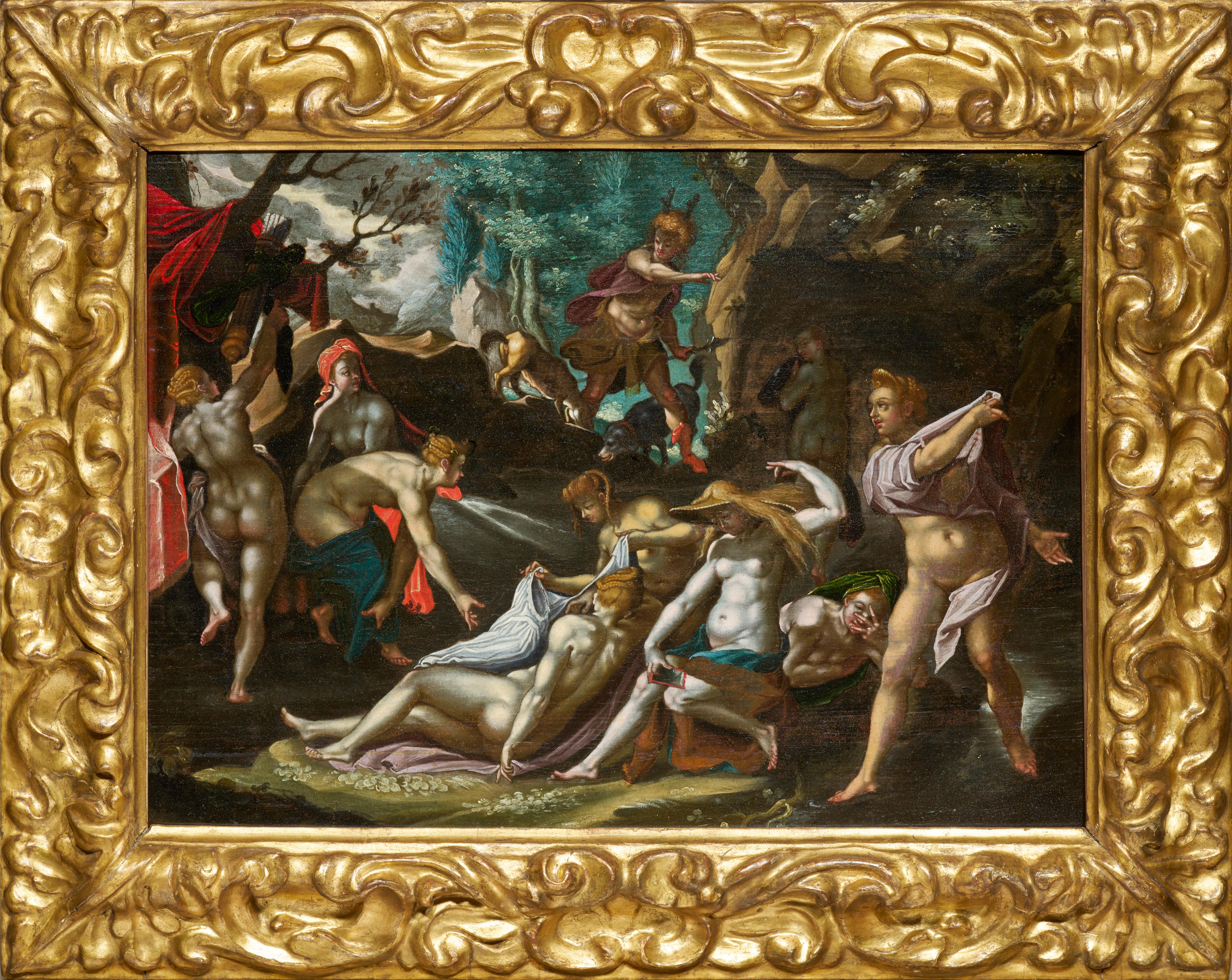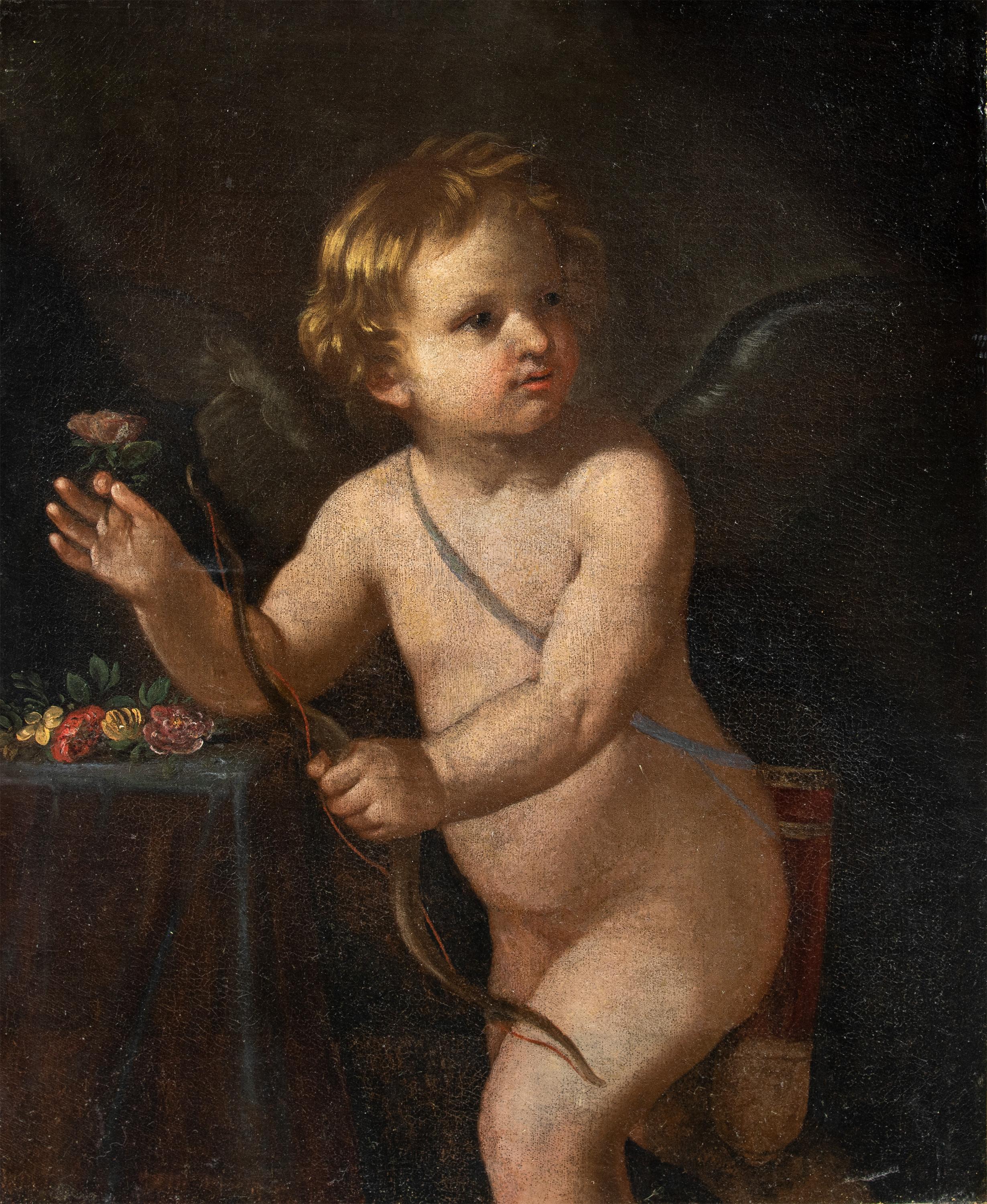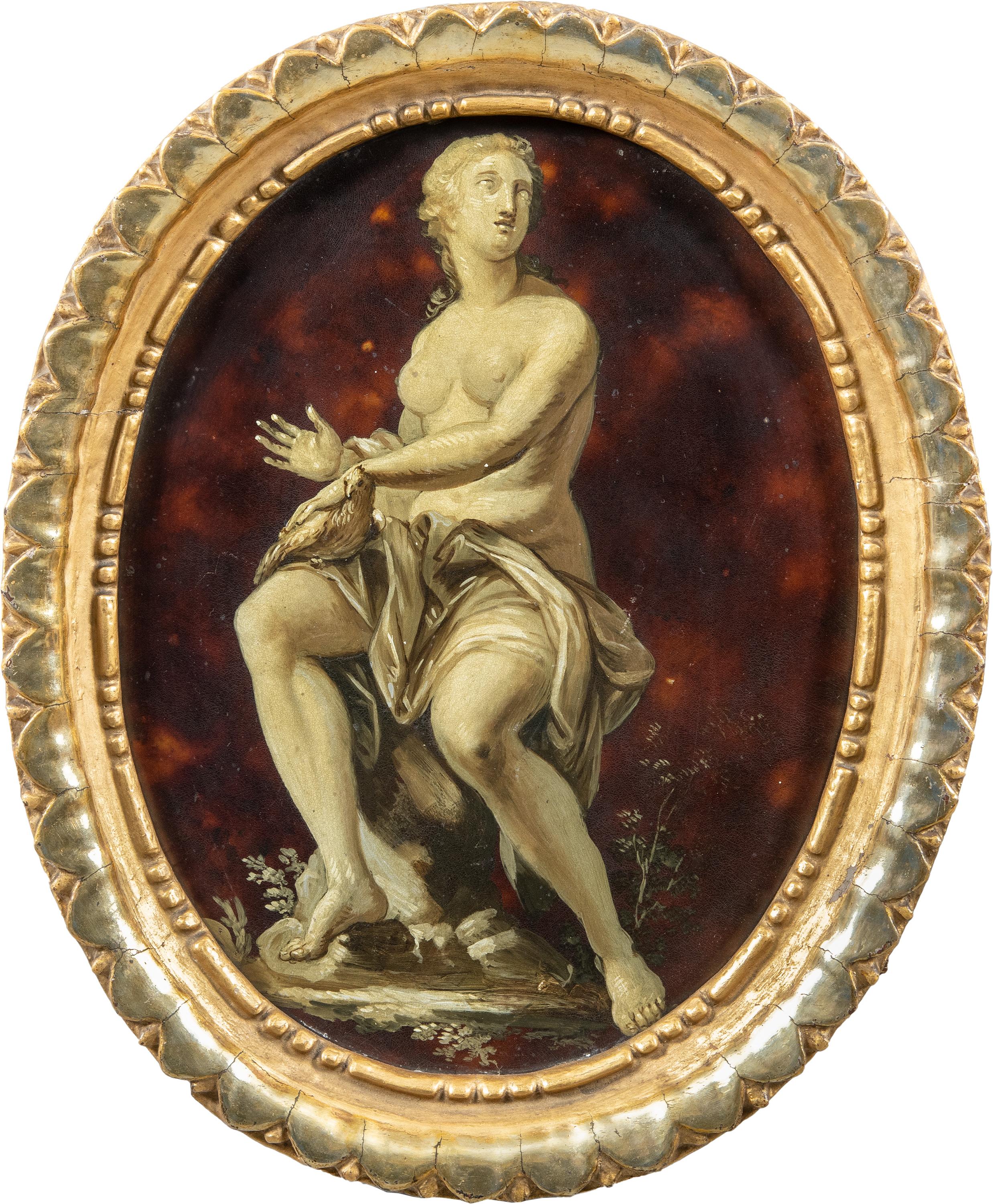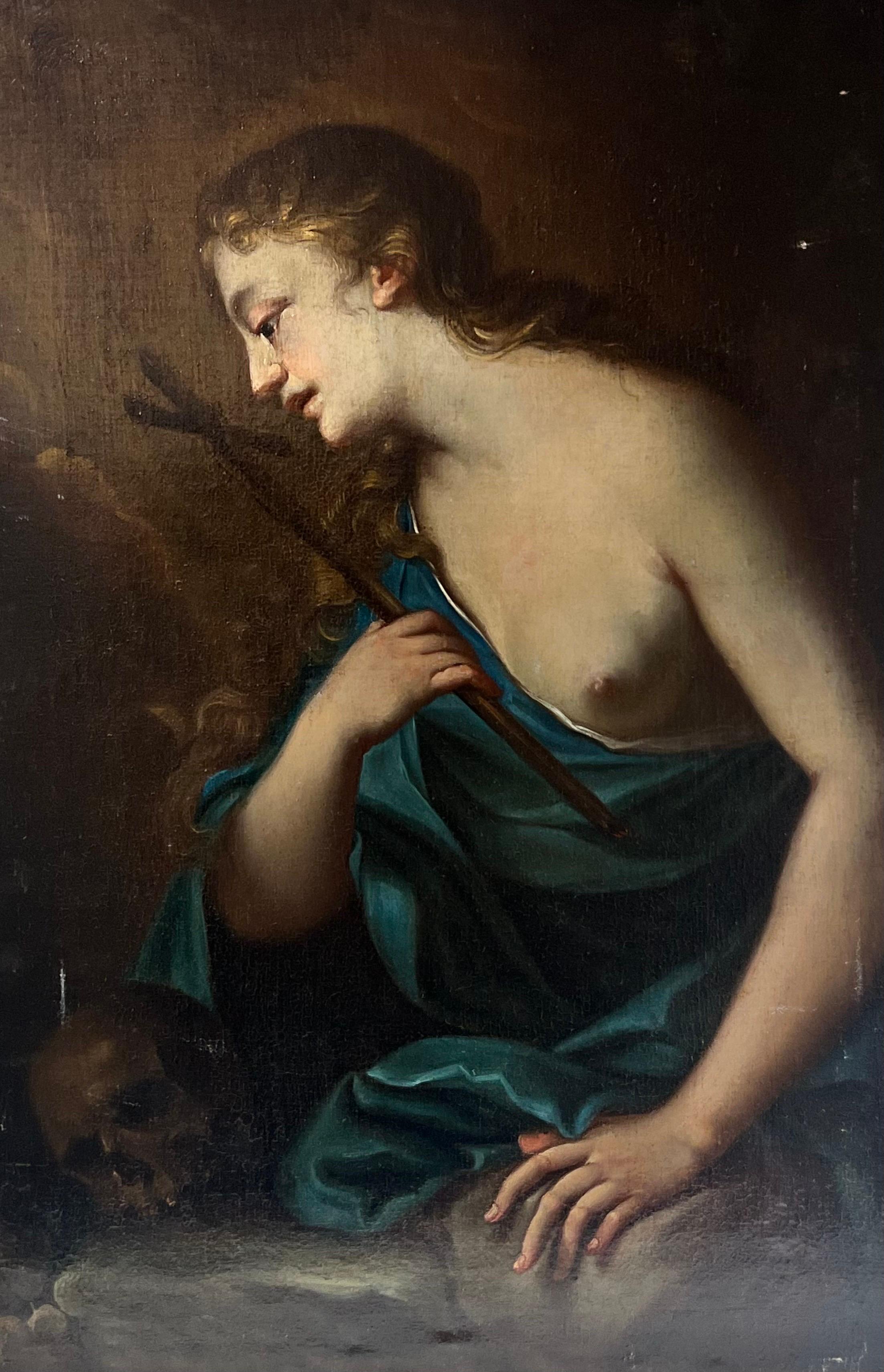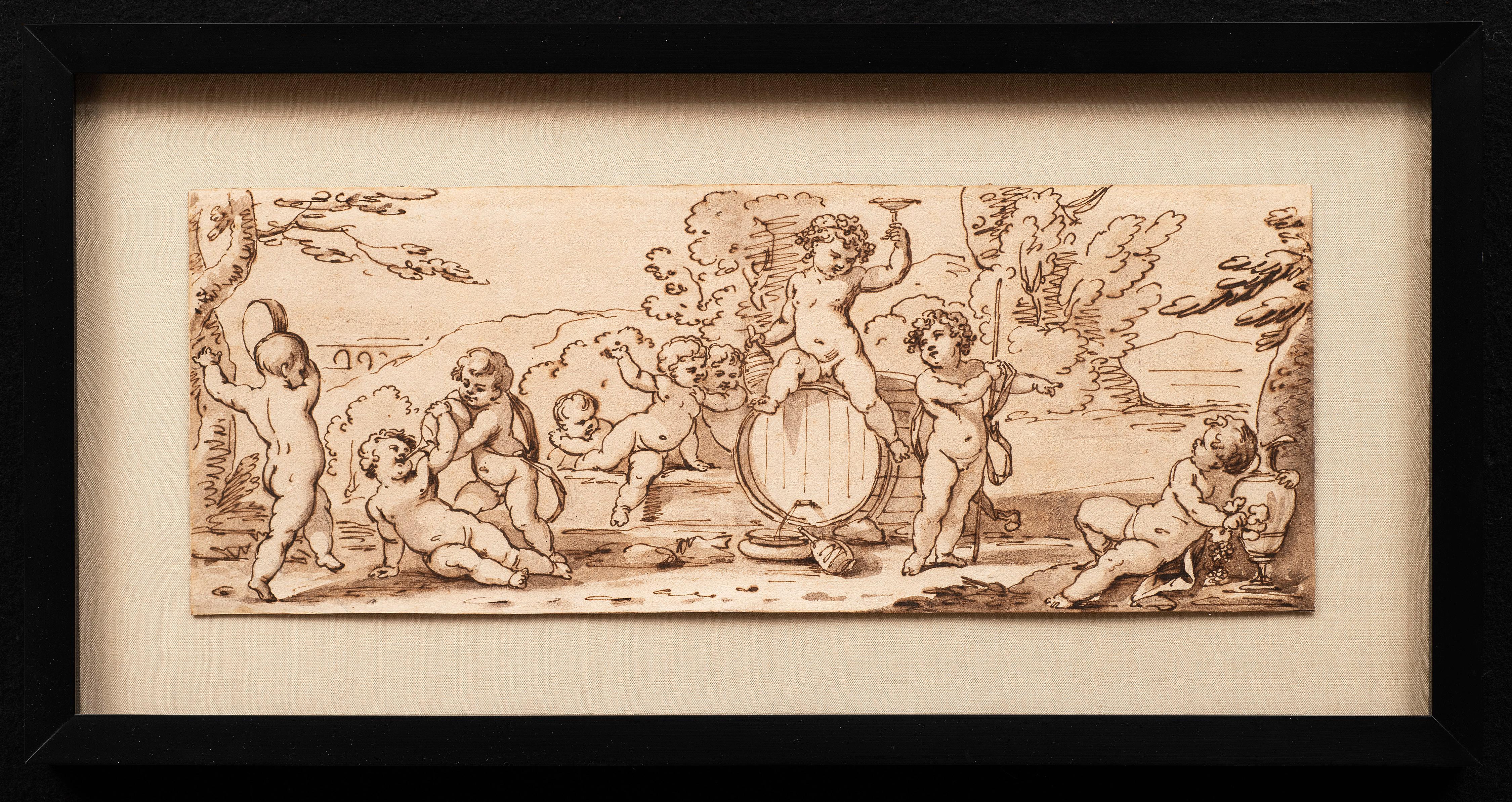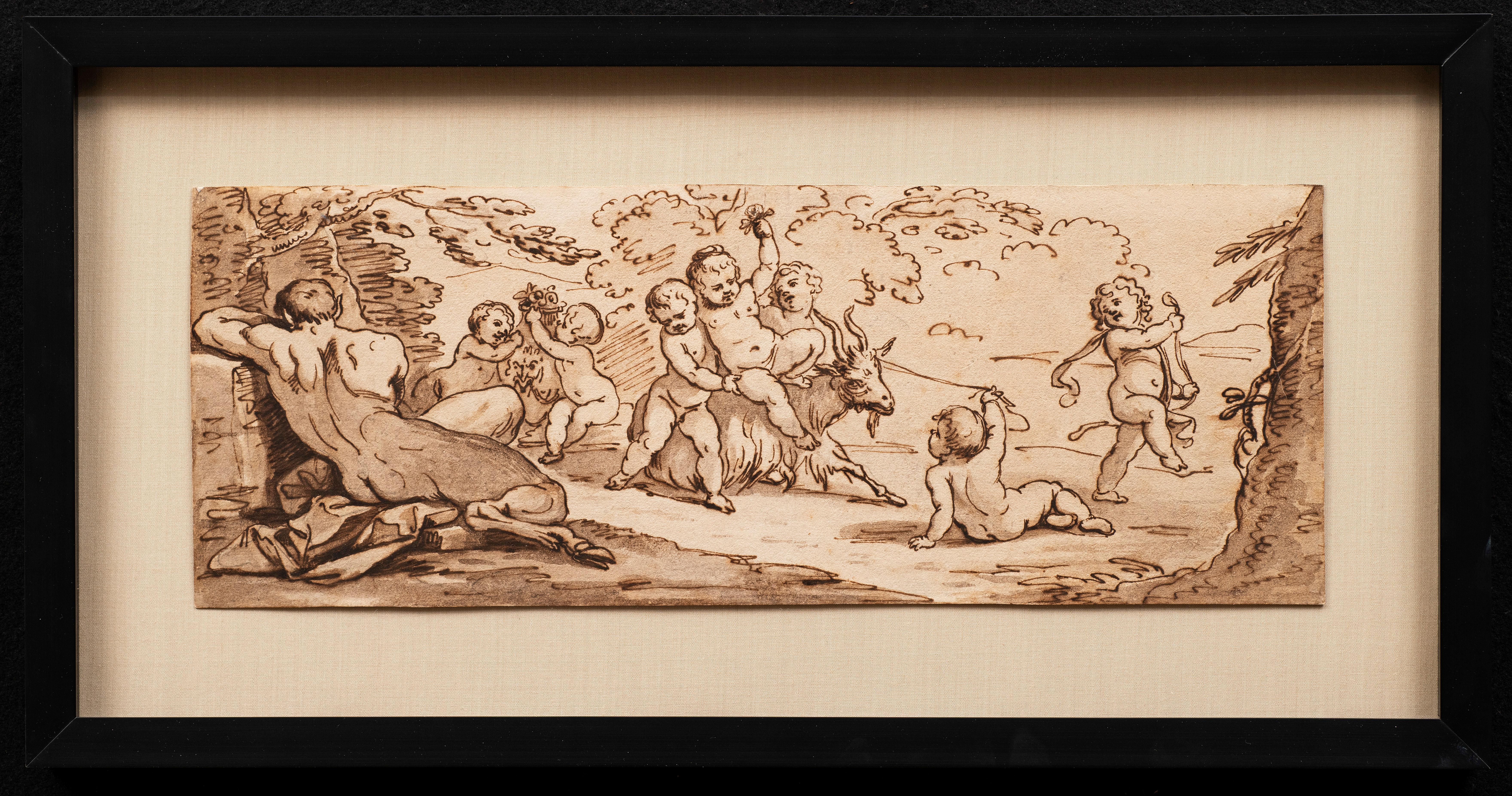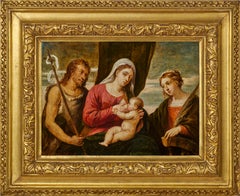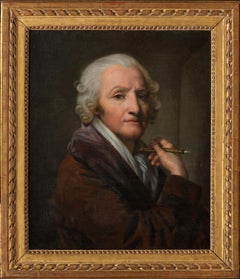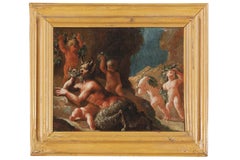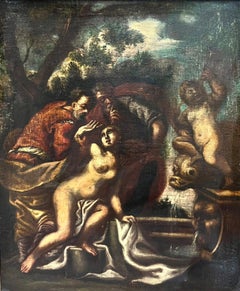
Satyr unveiling a Nymph - oil on panel by Johann Franz Meskens a Flemish painter
View Similar Items
Want more images or videos?
Request additional images or videos from the seller
1 of 12
Johann Franz Meskens Satyr unveiling a Nymph - oil on panel by Johann Franz Meskens a Flemish painter1721
1721
About the Item
- Creator:Johann Franz Meskens (Flemish)
- Creation Year:1721
- Dimensions:Height: 19.69 in (50.02 cm)Width: 19.5 in (49.53 cm)
- Medium:
- Movement & Style:
- Period:1720-1729
- Condition:12 3/16”x12” (31x30.5 cm); 19 11/16”x19 ½” (50x49.5 cm) framed Signed on the vase to the right of the nymph " MESKENS Fec. 1721 " Blackened wood frame with gilded acanthus friezes – Italy, early 18th century.
- Gallery Location:PARIS, FR
- Reference Number:1stDibs: LU1568210910772
About the Seller
5.0
Vetted Seller
These experienced sellers undergo a comprehensive evaluation by our team of in-house experts.
Established in 2020
1stDibs seller since 2021
8 sales on 1stDibs
Typical response time: 2 hours
More From This SellerView All
- Diana and Actaeon, a Mannerist painting after Joseph Heintz the ElderLocated in PARIS, FRThis painting seduced us with its rich colors. Depicting Diana and her companions surprised by Actaeon, it was inspired by an engraving by Aegidius Sadeler II after a painting by Jos...Category
17th Century Old Masters Nude Paintings
MaterialsOil, Wood Panel
- Virgin and Child, a paiting by David Teniers the Younger after Palma VecchioBy David Teniers the YoungerLocated in PARIS, FRProvenance: Dukes of Marlborough Collection, Blenheim Palace until its sale at Christie's London on 26 July 1886 (lot 172) English private collection until its sale at Christie's London on 11 December 1992 (lot 363) Erna Weidinger Collection (1923 - 2021) - Austria Literature : Georg Scharf - A list of the pictures in Blenheim Palace - Catalogue raisonné Part 2 - London 1862 (page 166 - number 199 "after Palma Giovane") Charles Davies...Category
1750s Old Masters Figurative Paintings
MaterialsOak, Oil
- Portrait of Jean-Baptiste Greuze, painted on linen by his daughter Anna GreuzeLocated in PARIS, FRThis replica of the last self-portrait of Jean-Baptiste Greuze painted in 1804, executed by his daughter Anna at her father's side and recently rediscovered, provides us with a poignant image of the great artist, represented with panache despite the disillusions of life. 1. Jean-Baptiste Greuze Jean-Baptiste Greuze was the sixth child of a roofer from Tournus and retained a certain rusticity in his behaviour from his provincial childhood, beyond his taste for describing picturesque scenes of the countryside. He initially started training with a little-known painter from Lyon, Charles Grandon, before his genius was recognised in Paris where he became a full-time student of the Académie (of Painting) in 1755. He exhibited his work for the first time at the Salon during the summer of 1755, before leaving on a trip to Italy in the company of Louis Gougenot, abbot of Chezal-Benoît. Upon his return to Paris, Greuze became a prolific painter, participating widely in the Salons held between 1759 and 1765, to which he sent no less than 63 paintings: numerous genre scenes (The Marriage Contract, The Beloved Mother), but also portraits of his family circle, of courtiers and art lovers, or of his colleagues. The Academy closed the doors of the Salons to him in 1767 for not having produced his reception piece within six months of his reception, as was the tradition. He worked actively on this painting (Emperor Severus rebukes Caracalla, his son, for trying to assassinate him ) until the summer of 1769, tackling historical and mythological subjects for the first time. Once this was completed, he was then fully admitted to the Academy, but as a genre painter, and not as an historical painter, which had been one of the greatest humiliations of his life. Greuze then refused any participation in events organised by the Academy or its successor, the Academy of Fine Arts until 1800. Abandoning history painting, he gave a new twist to genre scenes, bringing them closer to history painting, as in this pair of canvases which constitutes some of his masterpieces: The Paternal Curse: The Ungrateful Son and The Paternal Curse: The Punished Son . Married in 1759 to Anne-Gabrielle Babuti, the daughter of a Parisian bookseller, his marriage was unhappy and his wife probably frequently unfaithful. The institution of divorce enabled him to record their separation in 1793, keeping his two daughters Anna-Geneviève, born in April 1762, and Louise-Gabrielle, born in May 1764, with him. Little is known about his daughter Anna except that she was herself a painter and lived with her father until his death. It is likely that most of the paintings she produced up to that date were attributed to her father, whose technique she shared to a great extent, making it extremely difficult to establish an autonomous corpus of her paintings. Greuze died in his studio at the Louvre on March 21st 1805. The attention paid to the expressivity of his characters and the emotional charge they convey enabled Jean-Baptiste Greuze to enjoy immense popularity with the eighteenth-century public, and they still constitute Greuze's true modernity. As the artist said, "I dipped my brush in my heart". Greuze was also an exceptional draughtsman and a portraitist of immense talent and exceptional longevity who painted both the Dauphin (the son of Louis XV and father to Louis XVI) and the young Napoleon Bonaparte. 2. Greuze's self-portraits Greuze was very much influenced by Dutch paintings during all his life. While the source of his inspiration for genre scenes can be found in Gerard Dou...Category
Early 1800s Old Masters Portrait Paintings
MaterialsLinen, Oil
- Herminia and the Shepherds, a painting by Francesco de Mura (Napoli 1696 - 1782)By Francesco de MuraLocated in PARIS, FRIn this masterly painting, Francesco de Mura presents the meeting of Herminia and the shepherds, a famous episode taken from the seventh canto of Torquato Tasso's Jerusalem Delivered...Category
1760s Old Masters Figurative Paintings
MaterialsCanvas, Oil
- Italian Landscape with Jack Players, a painting by Gaspard Dughet (1615 - 1675)By Gaspard DughetLocated in PARIS, FRHere Gaspard Dughet offers us an idyllic vision of the Roman countryside. The stages follow one another in a perfectly structured composition, revealing here a lake, there travellers walking along, gradually leading our eye to the blue horizon. But behind its classical composition, this landscape is particularly interesting because of three anthropomorphic details that the artist has hidden, opening the way to a radically different interpretation... 1. Gaspard Dughet, a landscape artist in the light of Poussin Gaspard Dughet was born on June 4th, 1615 in Rome where his father, of French origin, was a pastry cook. He was probably named Gaspard in honour of his godfather Baron Gaspard de Morant, who was, or may have been, his father's employer. His older sister Jeanne married the painter Nicolas Poussin (1594 - 1655) on September 1st, 1630. The young Gaspard was apprenticed with his brother-in-law at the beginning of 1631, which led his entourage to name him Gaspard Poussin. The first preserved works of the painter date from the years 1633-1634 and were painted in Poussin’s studio. Around 1635, Gaspard Dughet became emancipated and began to frequent the Bamboccianti circle. In 1636, he became friends with the painter Jean Miel (1599 - 1656), but also with Pier Francesco Mola (1612 - 1666) and Pietro da Cortona (1596 - 1669). This was also the time of his first trips throughout Italy. The painter, although of French origin, appears never to have visited France. In 1646 he settled permanently in Rome. A recognized painter with a solid book of orders, he remained faithful to landscape painting throughout his life, alternating between cabinet paintings and large decorative commissions, using both oil and fresco. Nailed to his bed by rheumatic fever at the age of 58, he died on May 25, 1675. 2. Discovering an idealized landscape Beyond a relatively dark foreground that takes us into the landscape, we discover a vast bluish horizon: a plateau surrounded by deep ravines advances to the right, overhanging an expanse of water that sparkles below. A road winds through a mountainous mass as if leading us to the fortress that crowns it; another town appears in the distance at the foot of three conical mountains. The composition is rigorous, mineral, and structured by geometric volumes. The various stages in the landscape lead one to the next attracting the eye towards the horizon located in the middle of the canvas. The general impression is that of a welcoming and serene nature. In many places the paint layer has shrunk, or become transparent, revealing the dark red preparation with which the canvas was covered and accentuating the contrasts. Human presence is limited to three jack players, leaning against a mound in the foreground. Their long garments, which may evoke Roman togas, contribute to the timelessness of the scene. Close examination of the canvas reveals two other travellers on the path winding between the rocks. Made tiny by the distance, their introduction in the middle register, typical of Dughet's art, lengthens the perspective. While it is difficult to date the work of a painter who devoted his entire life to the representation of landscapes, it is certain that this painting is a work from his later years. The trees that occupied the foreground of his youthful compositions have been relegated to the sides, a stretch of water separates us from the arid mountains counterbalanced by two trees represented on the opposite bank. The introduction of this stretch of water in the middle of the landscape betrays the influence of the Bolognese and in particular of the Dominiquin (1581 - 1641) A number of similarities with a drawing in the British Museum might suggest a date around 1656-1657, since, according to Marie-Nicole Boisclair , it has been compared with the Prado's Landscape with the Repentant Magdalene, painted at that period. 3. Three amazing anthropomorphic details While some late Renaissance landscapes offer a radical double reading, allowing one to see both a face or a human body behind the representation of a landscape, it seems interesting to us to hypothesize that Gaspard Dughet had fun here by slipping in a few details that, taken in isolation, evoke human or animal figures. We will give three examples, looking closely at a cloud, the trunk of a broken tree and the top of a cliff. The main cloud could thus evoke a Christ-like face or that of an antique god...Category
1650s Old Masters Landscape Paintings
MaterialsOil
- Stag Hunting in the Vicinity of Nuremberg by a German Artist Peter von BemmelLocated in PARIS, FRThis small landscape shows a hunting scene: two riders are chasing a stag with their dogs at the edge of a forest. Signed by Peter von Bemmel, it is typical of the production of this...Category
1720s Old Masters Landscape Paintings
MaterialsCopper
You May Also Like
- 18th century By French maestro Bacchanal Oil on canvasLocated in Milano, LombardiaDuring a festive bacchanal a big satyr is eating grapes, lying on the ground and surrounded by a large group of putti who, with festoons and vine leaves, fill and populate the pictor...Category
18th Century Old Masters Figurative Paintings
MaterialsCanvas, Oil
- Mid 19th Century "Susanna And The Elders" After The Old Master by MartinelliLocated in San Francisco, CAOutstanding Mid 19th century old master "Susanna and the Elders" after Martinelli Brilliant old master painting of Susanna and the Elders. Original oil on canvas. Dimensions 26.5" ...Category
Mid-19th Century Old Masters Nude Paintings
MaterialsCanvas, Oil
$1,950 Sale Price58% Off - Large 1700 Italian Old Master Nude Bather with Classical Figures Water FountainLocated in Cirencester, GloucestershireItalian School, circa 1700's Classical figures in landscape oil on canvas, framed framed: 36 x 32 inches canvas: 30 x 25 inches provenance: private collection, UK condition: very goo...Category
Early 18th Century Old Masters Figurative Paintings
MaterialsCanvas, Oil
- 17th Century French Old Master Oil Painting Classical Robed Semi Nude FiguresLocated in Cirencester, Gloucestershire17th century French School circle of Nicolas Poussin (French 1594-1665) "Figures in Arcadia" oil on canvas, unframed canvas: 16 x 20 inches provenance: private collection, England condition: very good and sound condition Nicolas Poussin was a renowned French painter of the 17th century. He is considered one of the greatest figures of classical French Baroque art...Category
17th Century Old Masters Figurative Paintings
MaterialsCanvas, Oil
- FINE 17TH CENTURY ITALIAN OLD MASTER OIL ON CANVAS - THE BATHING OF BATHSHEBALocated in Cirencester, GloucestershireArtist/ School: Italian School, 17th century Title: The Bathing of Bathsheba Medium: oil painting, on canvas Size: frame: 23 x 19 inches, canvas: 18 x 14 inches Provenanc...Category
17th Century Old Masters Figurative Paintings
MaterialsCanvas, Oil
- Venus and AdonisBy Baron Pierre Narcisse Guerin (workshop)Located in Paris, FRBaron Pierre Narcisse GUERIN (Circle of) 1774-1833 French Venus et Adonis (Venus and Adonis) Oil on canvas Canvas: 53" high x 39 1/2" wide Frame: ...Category
19th Century Old Masters Figurative Paintings
MaterialsCanvas, Oil
Recently Viewed
View AllMore Ways To Browse
Italian Oil Painters
Italy Oil Painters
Oil Painting By Italian Painters
Almost A Pair
Art Flemish
Italy Nude Painting
Old Painting Oil On Panel
Ten Works Ten Painters
Antique Master Bedroom
Dressed In Nude
Ten Works By Ten Painters
Flemish Painters
Flemish Oil
German Paintings Nude
Nude From Behind
A Pair Of Small Paintings
Nude By Water
Small Nude Painting
